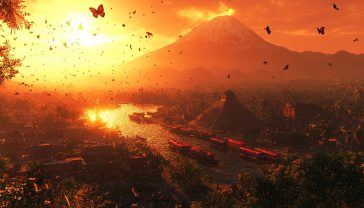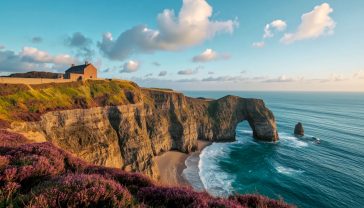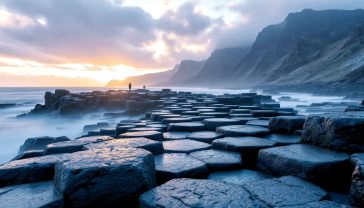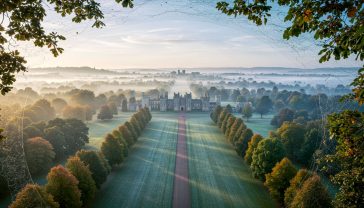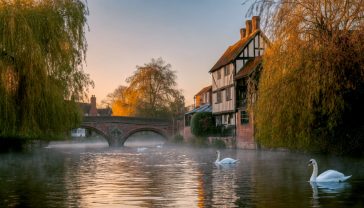The Enchanting Shores of the Lake District: A Haven of British Tranquility
Your definitive guide to the Lake District. Uncover its history, literary heritage, and stunning landscapes, with tips on the best walks, lakes, and hidden gems.
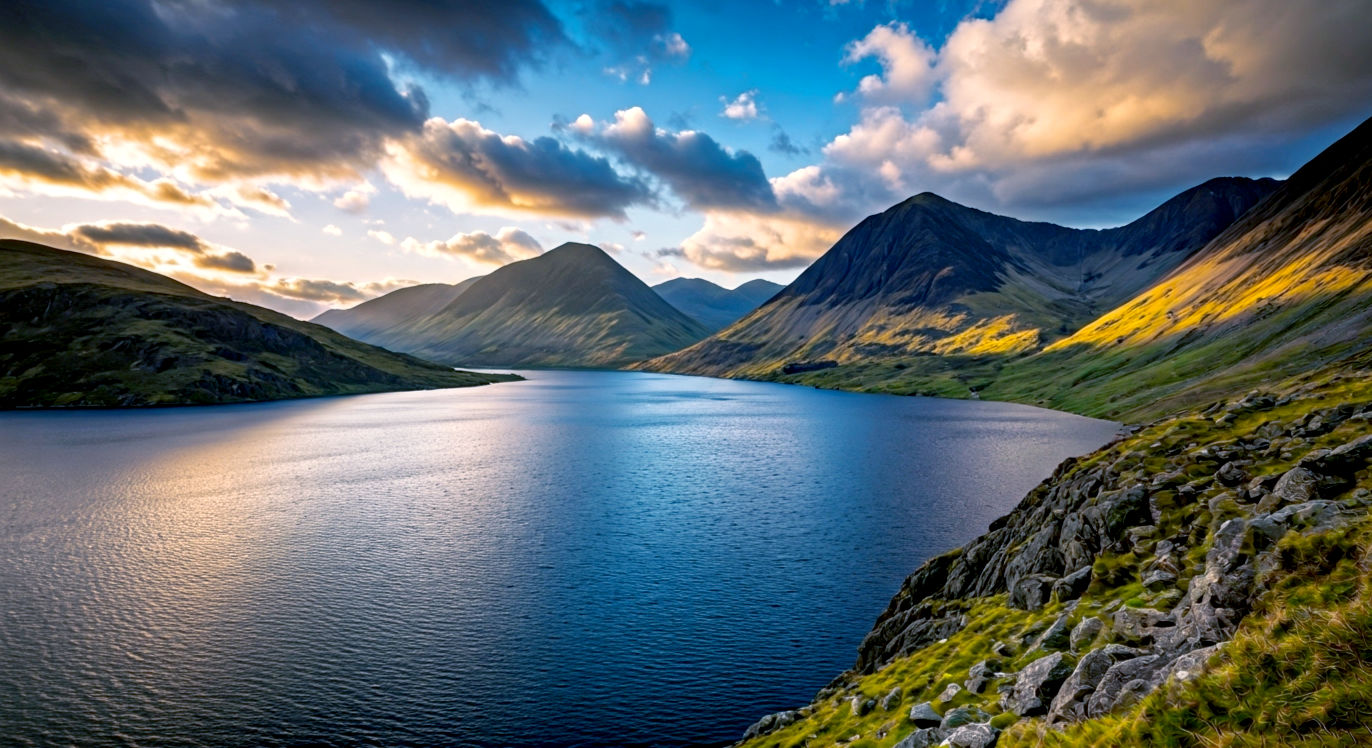
This post may contain affiliate links. If you make a purchase through these links, we may earn a commission at no additional cost to you.
The Lake District. Just the name conjures images of mist-wreathed mountains, glassy waters reflecting dramatic skies, and cosy pubs with crackling fires. For generations of Brits, it has been more than just a holiday spot; it’s a deep breath of fresh air, a place woven into the very fabric of our national identity. It’s the landscape that inspired poets to dream and walkers to wander, a ruggedly beautiful corner of Cumbria that feels both epic and intimately familiar.
But what is it about this cluster of lakes and fells that captures our hearts so completely? It’s not just the picture-postcard views, though there are plenty of those. It’s the feeling you get when you stand on the summit of a windswept peak, with nothing but the call of a buzzard and the vast, silent panorama for company. It’s the gentle lapping of water against a wooden jetty as you watch the sunset paint the sky in hues of orange and purple. It’s the sense of stepping back in time as you wander through slate-roofed villages where life moves at a slower, more considered pace.
This isn’t just a guide to the prettiest spots. This is a journey into the soul of the Lake District. We’ll explore the ancient rocks that form its bones, walk in the footsteps of the writers and artists who made it famous, and discover the simple joys of being immersed in one of the world’s most stunning natural landscapes. Whether you’re a seasoned fell-walker with worn-out boots or a first-time visitor wondering what all the fuss is about, consider this your invitation to uncover the enduring magic of the Lakes. It’s a place that, once visited, stays with you forever.
The Making of a Masterpiece: How Nature Forged the Lakes
Before we dive into the walks and the cream teas, it’s worth understanding how this incredible landscape came to be. The story of the Lake District is a dramatic tale of fire, ice, and immense geological forces, written over almost 500 million years. You don’t need a geology degree to appreciate it; you just need to look around. The very shape of the fells and the curve of the valleys tell a powerful story.
From Tropical Seas to Volcanic Fury
Believe it or not, this corner of England was once south of the equator, submerged under a warm, shallow sea. The oldest rocks here, the Skiddaw Group, are mostly mudstones and siltstones formed from sediment that settled on the seabed around 480 million years ago. You can see these dark, slaty rocks in the northern fells, like Skiddaw and Blencathra. They’re smooth and rolling because they’re softer and have been worn down over time.
Then came the fireworks. Around 450 million years ago, two ancient continents collided, triggering a period of intense volcanic activity. This wasn’t just a few gentle eruptions; it was a cataclysmic era of lava flows and colossal explosions that spewed out vast quantities of ash and rock. This created the tough, volcanic rocks of the Borrowdale Volcanic Group, which form the high, craggy central fells we know and love—think Scafell Pike, Helvellyn, and the Langdale Pikes. Their rugged, sharp-edged character is a direct result of their violent birth. These are the rocks that give the Lake District its dramatic, mountainous heart.
The Great Ice Age Sculptor
The fells were formed, but the landscape we see today was sculpted by a much colder force: ice. Over the last two million years, Britain has been plunged into several Ice Ages. Huge glaciers, sometimes over a kilometre thick, flowed from the central mountains, carving out the valleys as they went.
Imagine a giant scoop gouging its way through the rock, and you’ve got the right idea. The ice exploited existing river valleys, deepening and widening them into the classic U-shaped valleys we see today, like Great Langdale or Wasdale. These glaciers were immensely powerful. They scraped away soil and rock, plucked huge boulders from the mountainsides, and left behind the deep troughs that would eventually fill with water to become the famous lakes. Wastwater, England’s deepest lake, sits in a valley gouged out by a particularly mighty glacier.
As the glaciers melted, they dumped all the rock and debris they were carrying, forming mounds called moraines. Sometimes, these moraines acted as natural dams, blocking the ends of the valleys and helping the lakes to form. The result is the iconic ‘ribbon lakes’—long, thin bodies of water like Windermere and Ullswater—that are the defining feature of the region. So, when you’re standing by the shore of a lake, remember you’re looking at a landscape shaped by the colossal power of ancient ice.
A Landscape of Words: The Poets and Writers of the Lakes
You can’t talk about the Lake District without talking about the people who put it on the map. Long before it was a national park, it was a source of profound inspiration for a group of writers and thinkers who changed the way we see the natural world. They didn’t just describe the scenery; they found deep meaning and spiritual solace in it.
William Wordsworth: The Lakes’ Greatest Champion
At the heart of it all is William Wordsworth. Born in Cockermouth in 1770, he spent most of his life in and around Grasmere, and his poetry is inseparable from the landscape he roamed. For Wordsworth, nature wasn’t just a pretty backdrop; it was a living, breathing entity, a source of truth, and a moral guide. He believed that by spending time in nature, we could become better, happier people.
He famously described the district as a “sort of national property in which every man has a right and interest who has an eye to perceive and a heart to enjoy.” This was a radical idea at the time, and it laid the foundations for the creation of the national parks a century later.
His most famous poem, I Wandered Lonely as a Cloud, was inspired by a walk with his sister Dorothy near Ullswater, where they stumbled upon a long belt of daffodils. It perfectly captures that sense of sudden, unexpected joy that the Lake District can provide. To truly connect with Wordsworth, you can visit his homes: Dove Cottage in Grasmere, where he wrote some of his greatest works, and Rydal Mount, his grander home for his later years. Walking the coffin route between Grasmere and Rydal is like stepping directly into one of his poems.
The Romantics and Their Circle
Wordsworth wasn’t alone. He was part of a circle of friends and fellow writers known as the Lake Poets. Samuel Taylor Coleridge, author of The Rime of the Ancient Mariner, lived for a time at Greta Hall in Keswick and was a close friend and collaborator of Wordsworth. He was one of the first people to take fell-walking seriously as a recreational pursuit, scrambling up peaks for the sheer thrill of it.
Robert Southey, another resident of Greta Hall, was Poet Laureate for 30 years. Though less famous now, his influence was significant at the time. Together, these writers championed the idea of the ‘sublime’—the feeling of awe and even terror inspired by wild, untamed landscapes. Before them, mountains were often seen as dangerous, ugly places to be avoided. The Romantics taught us to see their beauty and power.
Beatrix Potter: More Than Just Peter Rabbit
While Wordsworth gave the Lakes its soul, Beatrix Potter helped to preserve its body. We all know her for her charming tales of Peter Rabbit, Jemima Puddle-Duck, and Mrs. Tiggy-Winkle, many of which were inspired by the animals and countryside around her beloved home, Hill Top, in Near Sawrey. The illustrations are filled with recognisable locations from the area.
But her legacy is much greater than her storybooks. With the money she earned from her writing, Potter became a savvy farmer and landowner. She was passionate about breeding the local Herdwick sheep—the hardy, smiley-faced sheep you see all over the fells—and was a fierce advocate for conservation. She worked closely with the fledgling National Trust, and when she died, she left over 4,000 acres of land, including 15 farms, to the Trust so that it could be protected for everyone to enjoy. Without Beatrix Potter, large parts of the Lake District we love today could have been lost to development. Her story is a powerful reminder of how one person’s vision can shape a landscape for centuries.
The Crown Jewels: Exploring the Lakes and Waters
The clue is in the name. The Lake District is home to 16 main bodies of water, each with its own unique character and charm. From the bustling shores of Windermere to the profound, silent depths of Wastwater, exploring the lakes is an essential part of any visit.
Windermere: The Great and Bustling Lake
Windermere is England’s largest natural lake, and it’s the vibrant, beating heart of the southern Lakes. At over 10 miles long, it feels almost like an inland sea. It’s the most accessible and busiest of the lakes, with the towns of Bowness-on-Windermere and Ambleside on its shores offering a hub of shops, restaurants, and attractions.
You can’t visit Windermere without getting on the water. The best way to appreciate its scale and beauty is by taking one of the famous Windermere Lake Cruises. The steamers glide between Lakeside, Bowness, and Ambleside, offering stunning views of the surrounding fells and wooded shorelines. You can hop on and off, perhaps visiting the Lakes Aquarium at Lakeside or taking the steam train on the Lakeside and Haverthwaite Railway.
For a more active experience, you can hire a rowing boat, kayak, or paddleboard. There’s something wonderfully peaceful about finding your own quiet cove and simply drifting for a while. For a classic view, walk up Orrest Head from Windermere village. It’s a short, easy climb that was the first fell Alfred Wainwright ever summited, and it offers a breathtaking panorama of the lake from end to end.
Ullswater: The Dark and Dramatic Lake
Often cited as England’s most beautiful lake, Ullswater has a wilder, more dramatic feel than Windermere. It snakes for nearly nine miles in a zigzag shape, surrounded by some of the most spectacular fells, including the mighty Helvellyn.
A trip on the Ullswater ‘Steamers’ is a must. These heritage vessels have been sailing the lake for over 150 years. A popular option is to take the steamer from Glenridding to Howtown and then walk the seven-mile path back along the lake’s wonderfully undeveloped eastern shore. It’s one of the best low-level walks in the country.
Ullswater is also the gateway to some serious mountain adventures. From the village of Glenridding, you can tackle Helvellyn via the infamous Striding Edge, a knife-edge ridge that’s not for the faint-hearted but provides one of Britain’s most thrilling mountain days. For something a little gentler, the walk to Aira Force waterfall is a delight. This stunning waterfall tumbles 65 feet into a rocky gorge, surrounded by beautiful woodland managed by the National Trust.
Coniston Water: A Lake of History and Speed
Coniston Water is a lake with a rich history of industry and adventure. The surrounding fells are riddled with old copper mines and slate quarries, and the Ruskin Museum in Coniston village tells the story of this industrial past.
The lake is also inextricably linked with speed. It was here that Donald Campbell made his fatal attempt on the world water speed record in his jet-powered boat, Bluebird K7, in 1967. His story is one of courage and tragedy, and it adds a poignant layer to the lake’s peaceful atmosphere. You can learn more about him at the Ruskin Museum and see the rebuilt Bluebird boat.
A lovely way to experience Coniston is by taking a trip on the Steam Yacht Gondola, a beautifully restored Victorian vessel. For the best views, take the path up the Old Man of Coniston, the rugged fell that looms over the village. The summit offers incredible views over the lake, Morecambe Bay, and even the Scafell range on a clear day.
Wastwater: The Wild and Brooding Lake
If you want to experience the raw, untamed spirit of the Lake District, head to Wasdale. This remote, awe-inspiring valley is home to Wastwater, England’s deepest and arguably most dramatic lake. The valley is guarded by a ring of giants: Scafell Pike (England’s highest mountain), Sca Fell, Great Gable, and Lingmell.
The view from the lake shore at the Wasdale Head end, looking up towards the screes and the high fells, was voted ‘Britain’s Favourite View’. There’s a primal, almost intimidating beauty to it. The screes plunge directly into the dark, cold water, and the whole place feels ancient and powerful.
There are no steamers or bustling towns here. Wasdale is a place for quiet contemplation and serious walking. It’s the main starting point for the ascent of Scafell Pike, a challenging but rewarding climb. At the end of the valley, you’ll find the tiny St Olaf’s Church, said to be England’s smallest, and the legendary Wasdale Head Inn, the spiritual home of British climbing. After a long day on the fells, there are few better places to be than by the fire in this historic pub, surrounded by fellow adventurers.
Up on the Fells: A Walker’s Paradise
For many, the true essence of the Lake District is found not by the lakes, but high up on the fells. This is a landscape made for walking. Whether you’re after a gentle stroll or a challenging mountain epic, there’s a path for you.
Getting Started: Low-Level Classics
You don’t need to be a seasoned mountaineer to enjoy the fells. Some of the most rewarding walks are at lower levels, offering fantastic views without a lung-busting ascent.
- Tarn Hows: This is perhaps the most famous and accessible walk in the Lakes. A well-maintained 1.5-mile path circuits this beautiful man-made tarn, offering picture-perfect views of the Langdale Pikes. It’s perfect for families and wheelchair users.
- Grasmere and Rydal Water: A gentle five-mile circular walk takes you around these two lovely small lakes, linked by the River Rothay. You’ll pass Wordsworth’s Dove Cottage and Rydal Mount, and can stop for a visit to the atmospheric Rydal Cave.
- Friar’s Crag, Keswick: This short walk from the Keswick lakeside leads to a stunning viewpoint over Derwentwater, with its wooded islands and the ‘Jaws of Borrowdale’ framing the view. It’s a massive reward for very little effort.
The Wainwrights: A Peak-Bagger’s Challenge
You can’t talk about fell-walking without mentioning Alfred Wainwright. Between 1955 and 1966, this Blackburn-born council treasurer produced a series of seven handwritten and hand-drawn guidebooks, A Pictorial Guide to the Lakeland Fells. They are works of art, filled with meticulous maps, witty observations, and a deep love for the mountains.
Wainwright described 214 fells, and climbing all of them—a pursuit known as ‘Wainwright bagging’—has become a lifelong passion for thousands of people. It’s a wonderful way to explore every corner of the national park, from the popular giants to the quiet, overlooked little hills.
Reaching the Heights: Three Iconic Climbs
For those with a head for heights and a good level of fitness, bagging one of the big peaks is an unforgettable experience.
- Scafell Pike (978m): As England’s highest point, this is on many people’s bucket list. It’s a serious undertaking. The most common route is from Wasdale Head, which is the shortest but also the steepest—a relentless slog up rocky paths. The route from Borrowdale via the Corridor Route is longer but more varied and scenic. The summit itself is a vast, boulder-strewn plateau, but on a clear day, the 360-degree view is peerless. You can see Scotland, Wales, the Isle of Man, and almost all of the Lake District fells.
- Helvellyn (950m): Often voted Britain’s favourite walk, Helvellyn offers a thrilling day out. The classic ascent from Glenridding is via Striding Edge, a narrow, rocky arête that requires some scrambling (using your hands as well as your feet). It’s exposed and exhilarating. You then return via Swirral Edge. For those who don’t fancy the ridges, a much easier (though still long) path leads up from Thirlmere to the west. The summit is a broad, flat plateau, but the views down to Red Tarn, nestled between the two edges, are magnificent.
- Catbells (451m): Don’t be fooled by its modest height; Catbells offers one of the best pound-for-pound views in the Lakes. Wainwright called it a “family fell where grandmothers and infants can climb the heights together.” It’s a short, sharp climb from the shores of Derwentwater, with a little bit of easy scrambling near the top that adds to the fun. The reward is a glorious view over Keswick, Derwentwater, and the surrounding high peaks. It’s the perfect first ‘proper’ fell.
A quick word on safety: The weather on the fells can change in an instant. Always check the forecast, wear proper walking boots, and carry waterproofs, extra layers, a map, a compass (and know how to use them!), and plenty of food and water. The mountains are beautiful, but they demand respect.
Beyond the Views: Activities and Adventures
While walking is the main event for many, the Lake District is a giant adventure playground offering a huge range of other activities.
On the Water
As we’ve seen, getting on the lakes is a must. Beyond the steamers, this is a world-class destination for kayaking, canoeing, and paddleboarding. The calmer waters of Derwentwater or the secluded bays of Ullswater are perfect for paddling. For something more exhilarating, you can try sailing or windsurfing on Windermere or Coniston. Numerous centres offer equipment hire and lessons for all abilities. Wild swimming has also become hugely popular, but be warned—the water is always cold! Always acclimatise slowly and never swim alone.
In the Forest
The Lake District has some wonderful forests to explore, offering a different perspective from the open fells. Grizedale Forest, between Coniston and Windermere, is a hub for outdoor activity. It’s famous for its sculpture trails, with around 40 artworks dotted throughout the woods, creating a unique outdoor gallery. It also has fantastic mountain biking trails, from gentle family-friendly routes to black-graded downhill runs. The Go Ape treetop adventure course is a brilliant challenge for thrill-seekers.
For the Adrenaline Junkie
The rugged landscape is perfect for adventure sports. The old slate quarries, like the one at Honister Pass, have been repurposed for via ferrata (climbing a route with fixed cables and ladders) and canyoning. The sheer rock faces of the Langdales and Borrowdale offer some of the best rock climbing in the UK, with routes that have been classic for over a century. Ghyll scrambling (or gorge walking) is another popular activity, which involves making your way up a mountain stream, scrambling over boulders, and jumping into plunge pools. It’s cold, wet, and brilliant fun.
Protecting a Precious Landscape: Conservation and the Future
The Lake District’s beauty is both its greatest asset and its biggest challenge. It was designated a National Park in 1951 to protect its stunning landscape from inappropriate development and to promote its enjoyment by the public. In 2017, it was awarded UNESCO World Heritage Site status, recognising its global cultural importance.
But this protection is a delicate balancing act. The park receives around 16 million visitors a year. This puts immense pressure on the fragile environment. Footpath erosion is a constant battle, with organisations like Fix the Fells working tirelessly to maintain and repair the most popular routes using traditional, sustainable methods.
Traffic congestion is another major issue, particularly in the central Lakes during peak season. The park authorities are encouraging visitors to use public transport, like the excellent bus services, or to ‘park and explore’, leaving their cars behind and using boats and boots to get around.
The future of farming is also crucial. The traditional hill farms, with their iconic Herdwick sheep, are a vital part of the landscape’s cultural heritage. They have shaped the scenery for centuries through grazing. Organisations like the National Trust are working with farmers to promote sustainable practices that support biodiversity and help manage the land in an environmentally friendly way.
As visitors, we all have a role to play. By following the Countryside Code—respecting the land, protecting the natural environment, and enjoying the outdoors responsibly—we can help ensure that this incredible place remains a haven of tranquility and beauty for generations to come. Leave no trace, take only memories, and support the local communities that are the lifeblood of this special part of the world.
The Lake District is more than just a destination; it’s a feeling. It’s the peace of a silent tarn, the thrill of a windswept ridge, and the warmth of a pub fire after a day in the hills. It’s a landscape that gets under your skin and calls you back, time and time again.
Further Reading
- The National Trust: https://www.nationaltrust.org.uk/visit/lake-district
- Lake District National Park Authority: https://www.lakedistrict.gov.uk/
- Visit Cumbria: https://www.visitcumbria.com/
- The Wainwright Society: https://www.wainwright.org.uk/

